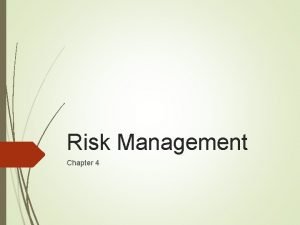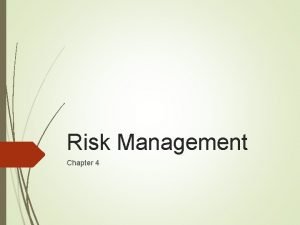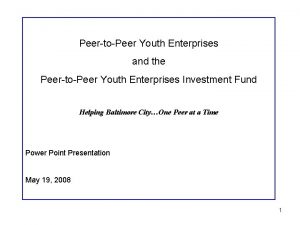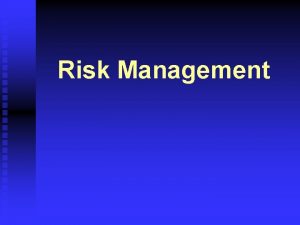RISK MANAGEMENT FOR ENTERPRISES AND INDIVIDUALS Chapter 6


















- Slides: 18

RISK MANAGEMENT FOR ENTERPRISES AND INDIVIDUALS Chapter 6 The Insurance Solution and Institutions

Learning Objectives Ø In this section you will learn: ØThe law of large numbers as the essence of insurance. ØHow insurance is defined. ØWhy so many risks cannot be insured by private insurance companies. ØThe definition of insurable risks by private insurers. ØWhy catastrophes such as floods are not insurable risks by private insurers. ØThe types of insurance company corporate structures. ØGovernmental insurance organizations. 2010 Flat Knowledge, Inc. ©© 2010 Flat. World Knowledge, -2 1 -6 2

Nature of Insurance Ø Insurance: A social device in which a group of individuals transfer risk to another party such that the third party combines or pools all the risk exposures together. ØInsureds: Individuals who transfer risk to a third-party. ØInsurer: The third party that accepts the risks transferred by insureds. Ø Law of large numbers: As a sample of observations is increased in size, the relative variation about the mean declines. 2010 Flat Knowledge, Inc. ©© 2010 Flat. World Knowledge, -3 1 -6 3

Nature of Insurance Ø Risk Transfer ØThe insurer assumes risk by promising to pay whatever loss may occur as long as it fits the description given in the policy and is not larger than the amount of insurance sold. ØThe insurance contract stipulates what types of losses will be paid by the insurer. ØMost insurance contracts are expressed in terms of money, although some compensate insureds by providing a service. 2010 Flat Knowledge, Inc. ©© 2010 Flat. World Knowledge, -4 1 -6 4

Nature of Insurance ØThe amount of risk that is transferred is usually the key to determining whether a certain accounting transaction is considered insurance or not. ØFinite risk programs are financial methods that can be construed as financing risk assumptions. 2010 Flat Knowledge, Inc. ©© 2010 Flat. World Knowledge, -5 1 -6 5

Nature of Insurance Ø Risk Pooling (Loss Sharing) ØLoss sharing is accomplished through premiums collected by the insurer from all insureds. ØPooling can be done by any group who wishes to share in each other’s losses. ØIt allows a more accurate prediction of future losses because there are more risk exposures. ØIn order for the law of large numbers to work, the pooled exposures must have approximately the same probability of loss. 2010 Flat Knowledge, Inc. ©© 2010 Flat. World Knowledge, -6 1 -6 6

Nature of Insurance ØInsurers need to discriminate, or classify exposures according to expected loss; the rates reflect each insured’s expected loss. ØThe phenomenon of selecting an insurer that charges lower rates for a specific risk exposure is known as adverse selection. ØSome insurance policy provisions are designed to reduce adverse selection. 2010 Flat Knowledge, Inc. ©© 2010 Flat. World Knowledge, -7 1 -6 7

Ideal Requisites for Insurability Ø A risk perfectly suited for insurance would meet the following requirements: ØThe number of similar exposure units is large. ØA major requirement for insurability is mass. ØThe loss exposures to be insured and those observed for calculating the probability distributions must have similarities. ØThe losses that occur are accidental. ØLosses are definite in time, place, and amount; the requirement of definiteness is essential to accumulate data for future predictions. 2010 Flat Knowledge, Inc. ©© 2010 Flat. World Knowledge, -8 1 -6 8

Ideal Requisites for Insurability ØSmall possibility of catastrophe. ØCatastrophic loss is loss that could imperil the insurer’s solvency; may occur in two circumstances. Ø All or many units of the group are exposed to the same loss-causing event; exposure units are susceptible to dependent loss when loss to one exposure unit affects the probability of loss to another. Ø A single large value may be exposed to loss. ØThe cost of coverage is economically feasible. ØFor insurance to be economically feasible for an insured, the size of the possible loss must be significant to the insured, and the cost of insurance must be small compared to the potential loss. 2010 Flat Knowledge, Inc. ©© 2010 Flat. World Knowledge, -9 1 -6 9

Table 6. 1 - Examples of Insurable and Uninsurable Risks 2010 Flat Knowledge, Inc. ©© 2010 Flat. World Knowledge, - 10 1 -6 10

Types of Insurance and Insurers Ø Personal, Group, or Commercial Insurance ØPersonal insurance: Insurance that is purchased by individuals and families for their risk needs; such insurance includes life, health, disability, auto, homeowner, and long-term care. ØGroup insurance: Insurance provided by the employer for the benefit of employees. ØCommercial insurance: Property/casualty insurance for businesses and other organizations. 2010 Flat Knowledge, Inc. ©© 2010 Flat. World Knowledge, - 11 1 -6 11

Types of Insurance and Insurers Ø Life/Health or Property/Casualty Insurance ØLife/health insurance: Insurance that covers exposures to the perils of death, medical expenses, disability, and old age. ØProperty/casualty insurance: Insurance that covers property exposures such as direct and indirect losses of property caused by perils such as fire, windstorm, and theft. 2010 Flat Knowledge, Inc. ©© 2010 Flat. World Knowledge, - 12 1 -6 12

Types of Insurance and Insurers Ø Private or Government Insurance Ø Voluntary or Involuntary Insurance Ø Insurers’ Corporate Structure ØStock Insurers: Insurers created for the purpose of making a profit and maximizing the value of the organization for the benefit of the owners. ØMutual Insurers: Insurers owned and controlled, in theory if not in practice, by their policyowners. ØProfits are shared with owners as policyowners’ dividends. 2010 Flat Knowledge, Inc. ©© 2010 Flat. World Knowledge, - 13 1 -6 13

Types of Insurance and Insurers Ø Captives, Risk Retention Groups, and Alternative Markets ØCaptive insurance company ØA company that provides insurance coverage to its parent company and other affiliated organizations. ØThe captive is controlled by its policyholder-parent; forming a captive insurer is an expensive undertaking. ØRisk retention group: A group that provides risk management and retention to a few players in the same industry who are too small to act on their own. 2010 Flat Knowledge, Inc. ©© 2010 Flat. World Knowledge, - 14 1 -6 14

Types of Insurance and Insurers ØAlternative markets are the markets of all selfinsurance programs. ØGovernmental risk pools: Pools formed for governmental entities to provide group self-insurance coverage. 2010 Flat Knowledge, Inc. ©© 2010 Flat. World Knowledge, - 15 1 -6 15

Types of Insurance and Insurers Ø Banks and Insurance Ø Government Insuring Organizations ØState Insuring Organizations ØAdminister unemployment compensation insurance programs. ØInsure worker’s compensation benefits. ØProvide temporary nonoccupational disability insurance, title insurance, or medical malpractice insurance. ØAssure the availability of property insurance, and indirect loss insurance in some states, to property owners of coastal areas exposed to hurricanes and other windstorms. 2010 Flat Knowledge, Inc. ©© 2010 Flat. World Knowledge, - 16 1 -6 16

Types of Insurance and Insurers ØFederal Insuring Organizations ØThe Social Security Administration ØThe Federal Deposit Insurance Corporation ØThe Securities Investor Protection Corporation ØThe Federal Crop Insurance Corporation Ø The Federal Crime Insurance Program ØFair Access to Insurance Requirements (FAIR) plans ØThe National Flood Insurance Program ØThe Veterans Administration ØThe Pension Benefit Guaranty Corp ØThe Overseas Private Investment Corporation (OPIC) 2010 Flat Knowledge, Inc. ©© 2010 Flat. World Knowledge, - 17 1 -6 17

Summary Ø The essence of insurance is risk transfer and risk pooling. Ø A risk perfectly suited for insurance must meet specific requirements. Ø Many types of insurance policies are available to families and organizations that do not wish to retain their own risks. 2010 Flat Knowledge, Inc. ©© 2010 Flat. World Knowledge, - 18 1 -6 18
 Risk management for enterprises and individuals
Risk management for enterprises and individuals Liquidity measures
Liquidity measures Fiduciary investment risk management association
Fiduciary investment risk management association Risk map risk management
Risk map risk management Financial management chapter 8 risk and return
Financial management chapter 8 risk and return Residual risk and secondary risk pmp
Residual risk and secondary risk pmp Business vs financial risk
Business vs financial risk Relative risk calculation
Relative risk calculation Population attributable risk
Population attributable risk National association of small and medium enterprises
National association of small and medium enterprises Meaning of micro enterprises
Meaning of micro enterprises Bsmepa
Bsmepa Office of small and medium enterprises promotion
Office of small and medium enterprises promotion International accounting and multinational enterprises
International accounting and multinational enterprises Fspos
Fspos Typiska novell drag
Typiska novell drag Nationell inriktning för artificiell intelligens
Nationell inriktning för artificiell intelligens Returpilarna
Returpilarna Shingelfrisyren
Shingelfrisyren


































